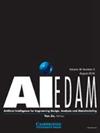基于语义相似度的方法,支持从EXPRESS到OWL的转换
IF 2.3
3区 工程技术
Q3 COMPUTER SCIENCE, ARTIFICIAL INTELLIGENCE
Ai Edam-Artificial Intelligence for Engineering Design Analysis and Manufacturing
Pub Date : 2023-01-01
DOI:10.1017/s0890060423000185
引用次数: 0
摘要
摘要产品数据共享是协同产品设计与开发的基础。尽管产品模型数据交换标准(STEP)通过提供统一的数据定义和描述来实现这一点,但它缺乏提供语义更丰富的产品数据模型的能力。许多研究者建议将STEP模型转换为本体模型,并提出了STEP描述语言EXPRESS到Web ontology language (OWL)的映射规则。在大多数研究中,这种映射是一个人工过程,既耗时又容易产生误解。为了支持这种转换,本研究提出了一种基于自然语言处理技术(NLP)的自动方法。从标题语义、文本语义和标题层次三个方面分析了EXPRESS和OWL参考手册中语言元素的相似性。本文主要关注语言元素之间的翻译,但同样的方法也应用于数据模型的定义。提出了两种基于自然语言处理的语义分析方法:结合随机行走(RW)和全局向量(GloVe)进行标题语义相似度分析;以及一种解码增强的文本语义相似度BERT解纠缠注意集成模型(DeBERTa)。评价结果表明了该方法的可行性。结果不仅涵盖了当前研究所映射的大多数语言元素,而且还确定了尚未包含的元素的映射。它还指出了为EXPRESS声明识别OWL段的可能性。本文章由计算机程序翻译,如有差异,请以英文原文为准。
A semantic similarity-based method to support the conversion from EXPRESS to OWL
Abstract Product data sharing is fundamental for collaborative product design and development. Although the STandard for Exchange of Product model data (STEP) enables this by providing a unified data definition and description, it lacks the ability to provide a more semantically enriched product data model. Many researchers suggest converting STEP models to ontology models and propose rules for mapping EXPRESS, the descriptive language of STEP, to Web Ontology Language (OWL). In most research, this mapping is a manual process which is time-consuming and prone to misunderstandings. To support this conversion, this research proposes an automatic method based on natural language processing techniques (NLP). The similarities of language elements in the reference manuals of EXPRESS and OWL have been analyzed in terms of three aspects: heading semantics, text semantics, and heading hierarchy. The paper focusses on translating between language elements, but the same approach has also been applied to the definition of the data models. Two forms of the semantic analysis with NLP are proposed: a Combination of Random Walks (RW) and Global Vectors for Word Representation (GloVe) for heading semantic similarity; and a Decoding-enhanced BERT with disentangled attention (DeBERTa) ensemble model for text semantic similarity. The evaluation shows the feasibility of the proposed method. The results not only cover most language elements mapped by current research, but also identify the mappings of the elements that have not been included. It also indicates the potential to identify the OWL segments for the EXPRESS declarations.
求助全文
通过发布文献求助,成功后即可免费获取论文全文。
去求助
来源期刊
CiteScore
4.40
自引率
14.30%
发文量
27
审稿时长
>12 weeks
期刊介绍:
The journal publishes original articles about significant AI theory and applications based on the most up-to-date research in all branches and phases of engineering. Suitable topics include: analysis and evaluation; selection; configuration and design; manufacturing and assembly; and concurrent engineering. Specifically, the journal is interested in the use of AI in planning, design, analysis, simulation, qualitative reasoning, spatial reasoning and graphics, manufacturing, assembly, process planning, scheduling, numerical analysis, optimization, distributed systems, multi-agent applications, cooperation, cognitive modeling, learning and creativity. AI EDAM is also interested in original, major applications of state-of-the-art knowledge-based techniques to important engineering problems.

 求助内容:
求助内容: 应助结果提醒方式:
应助结果提醒方式:


